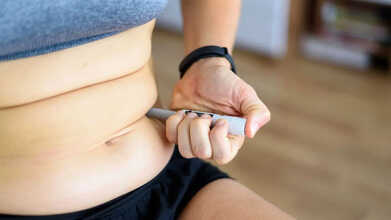- Health Conditions A-Z
- Health & Wellness
- Nutrition
- Fitness
- Health News
- Ayurveda
- Videos
- Medicine A-Z
- Parenting
Can Phone Bans In School Improve Students' Mental Well-being?

Credits: Canva
This digital era is all about catching up with trends, TikToks and reels, but at the cost of what? Many believe all of this happens at the cost of one's health and mental well-being. As a result, the grades of students, especially in high school, when they are exposed to social media the most, start to drop. However, a study based on the University of Birmingham's findings, peer-revied and published by the Lancet's journal for European health policy compared 1,277 students and the rules their 30 different secondary schools had for smartphone use at break and lunchtimes.` The study found something else, contrary to the popular belief.
What Did The Study Find?
The study found that banning phones in school is not linked to pupils getting higher grades or having a better mental wellbeing. The study found that a student's sleep, classroom behavior, exercise or how long they spend on their phones did not seem much different for schools with phone bans versus schools without it.
However, the study did find that spending longer time in social media or on smartphones in general may be linked to such measures. This was the first study in the world that looked at school phone rules along with the children's health and education.
In an interview to the BBC, Dr Victoria Goodyear, study's lead author said, that the findings are not against smartphone bans in school, but, a suggestion that bans in isolation are not enough to tackle the negative impacts.
The focus must be on reducing how much time the student spends on their phone, which cannot just be supervised in school.
How Was The Study Conducted?
The schools were chosen from a sample of 1,341 mainstream state schools in England. Among these the behavior of student form schools that banned the smartphones versus those who did not ban it were studied to find out that schools restricting smartphone use did not seem to see the intended improvements on health, wellbeing and focus of the student, as one would have wished to.
The study also used the internationally recognized Warwick-Edinburg Mental Well-Being Scale, a measure of mental well-being focusing entirely on positive aspects. It is a 14-item scale with 5 response categories. This method was used to determine the wellbeing of the children who participated in the research. It further looked at students' anxiety and depression levels.
It also asked from teachers about whether their students were on target, below target or above target in English and maths.
What Do The Students Feel?
When asked students, they said that the smartphone ban forces you to hang out and chat with your friends and some of them think in lower school, it has helped them spend less time scrolling social media and making lots of friends.
Experts point out that the important part is to help students learn to use their phone in a safe and controlled space. This way, phone-related issues, especially distraction, its impact on your mental health, will be much less. The answer is not ban, but the use of the smartphone in a controlled environment, so students learn to value the "freedom" they have been given to use them at break and lunch.
Simple Blood Tests Detecting Multiple Cancer; Do They Really Work?

Credits: iStock
Can a simple test detect multiple cancer all at once? The New York Times reports that in the spring of 2021, this idea had first came into being, where a simple test could detect different cancer including those that do not have any regular screening. Now, the buzz is even louder around that. The test is called Galleri, and data suggest that its performance has improved.
Many companies are racing to develop this multi-cancer early-detection blood test and while none are yet approved by the federal regulators, people are already demanding for it. They cost hundreds of dollars.
The company that manufactures Galleri, GRAIL, said that a total of 420,000 tests had been prescribed so far, which shows a surge from 180,000 as of March 31, 2024. The company is also planning to apply for approval from the Food and Drug Administration (FDA), next year. It is also seeking that Medicare would cover the tests.
What Does The Research On This New Cancer Detection Test Say?
While the demand is there, the research on it is limited. Cristian Tomasetti, the director of the Center for Cancer Prevention, Early Detection and Monitoring at City of Hope, a cancer center in Southern California told the NYT, "It feels like the airplane is being built while flying."
Most of the available evidence so far comes from studies conducted by GRAIL and other test developers. In GRAIL’s latest study, nearly 99 percent of the around 23,000 people screened using the Galleri test received a negative result. However, 40 percent of positive findings were later found to be false, and the test detected only 40 percent of cancers that were diagnosed within a year, missing the remaining 60 percent.
Case Study
The idea behind this test is that when cancer is detected earlier, it is easier to treat. Dr. Elizabeth O’Donnell, who heads a multi-cancer early detection clinic at Dana-Farber Cancer Institute in Boston described the experience as doing something truly meaningful for a patient, particularly when the cancer involved has no established screening test.
That possibility became real for William Hill, a 56-year-old firefighter from Brockton, Massachusetts, who took the Galleri blood test last year during a firefighters’ conference. Firefighters are often exposed to carcinogens while on duty. His blood sample was sent to a North Carolina laboratory, where scientists analyzed fragments of DNA for patterns that could indicate cancer and identify its likely origin.
Two weeks later, the result came back: a cancer signal had been detected.
Hill said he initially hoped the finding was a mistake, especially since he had already been treated for testicular cancer in the past. Further testing at Dana-Farber, including an abdominal CT scan, confirmed metastatic testicular cancer, and treatment began right away.
Looking back, Hill realized that symptoms he had brushed off, such as back pain and frequent urination, were caused by a tumor pressing against his kidney. At the time, he had attributed them to aging and the physical demands of his job.
While it remains unclear whether the test ultimately changed his long-term prognosis, Hill believes it prompted earlier treatment. He said that without the test, he likely would not have suspected cancer and might have delayed care, allowing the tumor to grow further.
Stories like Hill’s point to the promise of multi-cancer blood tests. However, there is still no solid evidence that they reduce cancer-related deaths. Such proof exists for screenings like breast, cervical, colon, and lung cancer, based on large randomized trials conducted over many years.
Weight Loss Jabs: What Happens To Your Body When You Stop Taking Them?

Credits: Canva
Weight-loss jabs, or GLP-1 receptor agonists, have provided many people with results that diets alone could not achieve. For those struggling with constant cravings, these medications have quieted the persistent “food noise” that often drives overeating. They have transformed not only body shapes but also self-confidence and daily habits.
Yet questions remain: can people safely stop taking these drugs, and what happens to the body when they do? These are still largely unknown, as the drugs are relatively new. GLP-1s mimic a natural hormone that controls hunger, but the long-term effects are only beginning to be understood. Additionally, for the estimated 1.5 million people in the UK paying privately for these injections, maintaining treatment can be costly.
Two women, Tanya and Ellen, share their personal experiences with the BBC on weight-loss jabs and what life was like when they attempted to stop.
Weight Loss Jabs: Tanya Hall’s Experience
Tanya, a sales manager in the fitness industry, initially started taking Wegovy to challenge her own perceptions about weight and authority. She often felt overlooked or undervalued because of her size, and hoped that losing weight would change how others treated her, as per BBC.
Early in treatment, Tanya experienced side effects including nausea, headaches, sleep issues, and hair loss, which she describes as clumps coming out. Despite this, she steadily lost weight—six stone (38 kg) over 18 months—and the injections quieted the relentless urge to eat.
However, every time she tried to stop, her appetite surged within days, leaving her horrified at her own eating. Now, Tanya continues the medication, feeling it has become essential to maintaining her weight and the confidence it brings.
Weight Loss Jabs: What Happens To Your Body When You Stop Taking Them?
Wegovy’s manufacturer, Novo Nordisk, stresses that treatment decisions should be made with medical guidance and that side effects must be considered. Lifestyle GP Dr. Hussain Al-Zubaidi likens stopping GLP-1s abruptly to being hit by a “tsunami” of hunger.
Research shows that within one to three years of stopping these medications, people can regain 60–80% of the weight they lost. This highlights how these drugs work not just by reducing appetite temporarily but by fundamentally altering hunger cues.
Weight Loss Jabs: Ellen Ogley’s Journey
Ellen turned to Mounjaro after reaching a critical point in her life. Her weight had put her at risk during surgery, and emotional binge eating dominated her daily habits. Once on the medication, Ellen noticed her compulsive eating completely stopped.
Over 16 weeks, she lost 3 st 7 lb (22 kg) and began tapering off the injections over six weeks. She focused on developing a healthier relationship with food, creating balanced meals, and incorporating exercise into her routine. Despite some weight creep after stopping, she has since lost a total of 51 kg and now feels confident her habits are sustainable.
Weight Loss Jabs: The Importance of Support
Dr. Al-Zubaidi emphasizes that exiting GLP-1 treatment safely requires guidance and long-term support. NICE recommends at least a year of tailored advice after stopping injections to help individuals maintain their weight and prevent relapse, as per BBC.
For patients paying privately, such structured support may not always be available, increasing the risk of regaining weight. Lifestyle, mindset, and environmental factors play a significant role in long-term outcomes.
Tanya has chosen to continue with her medication, aware of the pros and cons, while Ellen has closed that chapter and built a sustainable routine for life after Mounjaro.
Weight-loss jabs can dramatically change appetite and body weight, but stopping them can be challenging. The transition off these drugs requires careful planning, support, and lifestyle adjustments. As Tanya and Ellen’s experiences show, the journey varies by individual, and long-term strategies are essential to maintaining health and weight loss results.
Eli Lilly, the manufacturer of Mounjaro, states that patient safety is its top priority and that it continually monitors and reports information on treatment outcomes to regulators and prescribers.
Flu Cases Surge Across The US: How Long Does The Super Flu Remain Contagious?

Credits: Canva
Flu Symptoms: Seasonal infections are spreading across the United States just as the holiday travel rush gets underway, worrying health officials about fresh spikes during family get-togethers. Flu and norovirus cases are rising in several states, while COVID-19 continues to circulate at lower but consistent levels. Together, these illnesses are adding strain on hospitals as millions of people plan to travel in the days ahead.
Flu: What Is Super Flu?
“Super flu” is not a clinical term, but it is often used to describe a flu season that feels more aggressive or spreads faster than usual. This is typically linked to a dominant strain of influenza A. The current surge is being driven by a mutated influenza A strain known as H3N2 subclade K. Health officials say this strain has become the leading flu variant in the US, accounting for roughly 89 percent of H3N2 samples analysed since late September, according to genetic sequencing data from the Centers for Disease Control and Prevention (CDC).
This variant emerged after the 2025–26 flu vaccine was formulated, meaning the vaccine may not be as closely matched as in earlier seasons. While the shot still offers protection against severe disease, experts note that the mismatch could allow the virus to spread more easily.
Flu Symptoms 2025: What Symptoms Should People Watch For?
The symptoms seen in the current flu wave are largely familiar. People may develop fever, chills, extreme tiredness, cough, and body aches. Doctors, however, caution that the wider spread could result in more serious cases, particularly among people who are at higher risk.
CDC estimates indicate that the US has already seen about 4.6 million flu cases this season, along with nearly 49,000 hospital admissions and around 1,900 deaths. Flu activity increased sharply in mid-December, with test positivity jumping from 8.1 percent to 14.3 percent within a single week.
Flu Symptoms 2025: How To Reduce The Risk
Doctors recommend staying home when feeling unwell, washing hands often, especially to limit norovirus spread, and considering vaccination against flu and COVID-19. Even when the strain match is not ideal, experts stress that vaccines remain crucial in reducing the risk of severe illness, hospitalisation, and death.
Flu Cases In The US: How Contagious Is Superflu?
In terms of how easily it spreads, it behaves much like regular flu, which is known to be highly contagious.
Someone with flu can pass on the virus from around one day before symptoms appear and continue to be contagious for five to seven days after becoming sick. Children, older adults, and those with weakened immune systems may remain infectious for a longer period.
The virus mainly spreads through respiratory droplets released when an infected person coughs, sneezes, speaks, or breathes near others. It can also spread through contact with contaminated surfaces, followed by touching the mouth, nose, or eyes. Crowded indoor settings, poor airflow, and close contact make transmission far more likely, which explains why flu spreads quickly during peak season.
What makes a so-called “super flu” seem more contagious is not a new way of spreading, but higher case numbers, quicker community transmission, and stronger symptoms, all of which increase coughing, fever, and the amount of virus released.
© 2024 Bennett, Coleman & Company Limited

